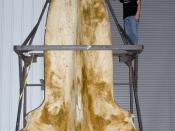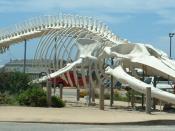Erya Ni
Commentary: Prose "The biggest heart in the world is inside the blue whaleâ¦"
When one's innocence diminishes proportionally to age, one's mind becomes almost completely exclusive to the owner for fear of seeming too "naked" and vulnerable. In this extract from The American Scholar, the anonymous author is interested in the exploration of diminishing innocence and how it effects the intimacy between people. The author recognizes the inherent need for social organisms to interact and acknowledges emotional susceptibility as a shared trait amongst sentient beings, no matter the size, and justifies the above two points through the provision of scientific facts and the effectiveness of emotionally appealing imagery. More importantly, the author intends to provide a solution for dealing with despair and lack of faith.
The author endeavours to put forth as much scientific evidence to support the statement "No living being is without interior liquid motion.
We all churn inside". From the largest animal in the world down to unicellular bacteria, the speaker presents biological facts specifically targeted at the organism's physical traits such as the number of chambers inside the heart. The reader is then gradually linked back to human behavioural patterns as the speaker addresses the behavioural paradox that although humans tend to live in a house with other people, we actually all live in seclusion, in a metaphorical "house of heart". This estrangement from society is an attempt to protect one's heart from being "bruised and scarred, scored and torn" for the second time after suffering from the first. The use of alliteration in "scarred, scored" provides the reader with a sensual imagery of a defenceless heart that will in due time be "scored and torn". The rhythmic repetition of the monosyllabic adjectives "scarred", "bruised", "scored" and "torn", each pair separated by...


